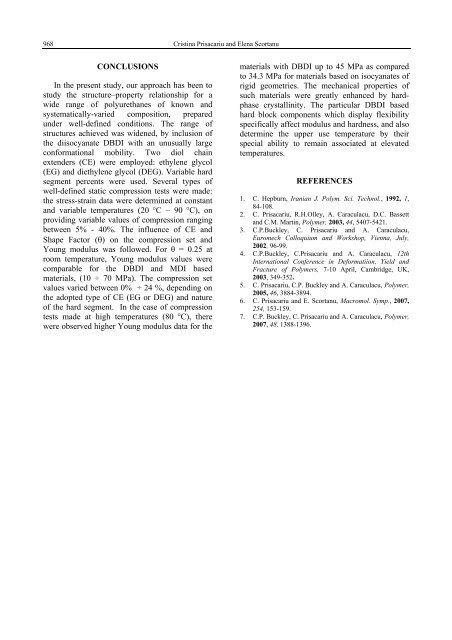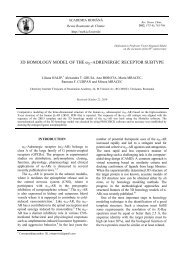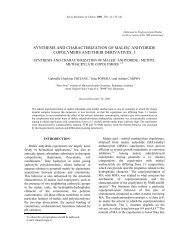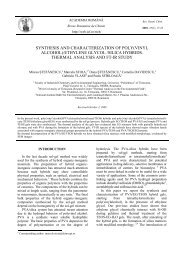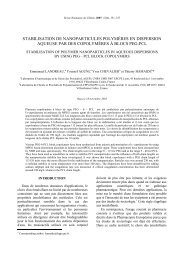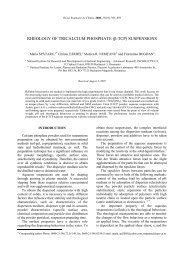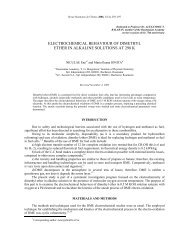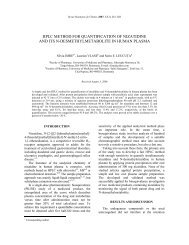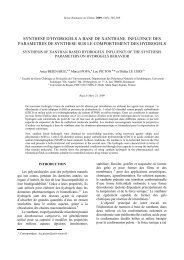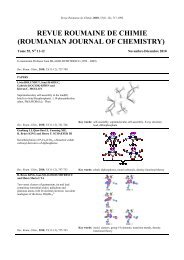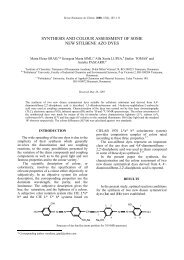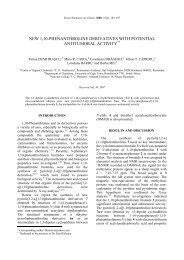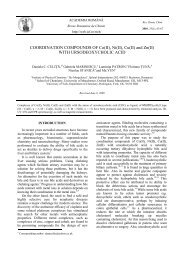the thermal behaviour of selected crosslinked polyurethanes as ...
the thermal behaviour of selected crosslinked polyurethanes as ...
the thermal behaviour of selected crosslinked polyurethanes as ...
- No tags were found...
Create successful ePaper yourself
Turn your PDF publications into a flip-book with our unique Google optimized e-Paper software.
968 Cristina Prisacariu and Elena ScortanuCONCLUSIONSIn <strong>the</strong> present study, our approach h<strong>as</strong> been tostudy <strong>the</strong> structure–property relationship for awide range <strong>of</strong> <strong>polyurethanes</strong> <strong>of</strong> known andsystematically-varied composition, preparedunder well-defined conditions. The range <strong>of</strong>structures achieved w<strong>as</strong> widened, by inclusion <strong>of</strong><strong>the</strong> diisocyanate DBDI with an unusually largeconformational mobility. Two diol chainextenders (CE) were employed: ethylene glycol(EG) and diethylene glycol (DEG). Variable hardsegment percents were used. Several types <strong>of</strong>well-defined static compression tests were made:<strong>the</strong> stress-strain data were determined at constantand variable temperatures (20 °C – 90 °C), onproviding variable values <strong>of</strong> compression rangingbetween 5% - 40%. The influence <strong>of</strong> CE andShape Factor (θ) on <strong>the</strong> compression set andYoung modulus w<strong>as</strong> followed. For θ = 0.25 atroom temperature, Young modulus values werecomparable for <strong>the</strong> DBDI and MDI b<strong>as</strong>edmaterials, (10 ÷ 70 MPa). The compression setvalues varied between 0% ÷ 24 %, depending on<strong>the</strong> adopted type <strong>of</strong> CE (EG or DEG) and nature<strong>of</strong> <strong>the</strong> hard segment. In <strong>the</strong> c<strong>as</strong>e <strong>of</strong> compressiontests made at high temperatures (80 °C), <strong>the</strong>rewere observed higher Young modulus data for <strong>the</strong>materials with DBDI up to 45 MPa <strong>as</strong> comparedto 34.3 MPa for materials b<strong>as</strong>ed on isocyanates <strong>of</strong>rigid geometries. The mechanical properties <strong>of</strong>such materials were greatly enhanced by hardph<strong>as</strong>ecrystallinity. The particular DBDI b<strong>as</strong>edhard block components which display flexibilityspecifically affect modulus and hardness, and alsodetermine <strong>the</strong> upper use temperature by <strong>the</strong>irspecial ability to remain <strong>as</strong>sociated at elevatedtemperatures.REFERENCES1. C. Hepburn, Iranian J. Polym. Sci. Technol., 1992, 1,84-108.2. C. Prisacariu, R.H.Olley, A. Caraculacu, D.C. B<strong>as</strong>settand C.M. Martin, Polymer, 2003, 44, 5407-5421.3. C.P.Buckley, C. Prisacariu and A. Caraculacu,Euromech Colloquium and Workshop, Vienna, July,2002, 96-99.4. C.P.Buckley, C.Prisacariu and A. Caraculacu, 12thInternational Conference in Deformatiion, Yield andFracture <strong>of</strong> Polymers, 7-10 April, Cambridge, UK,2003, 349-352.5. C. Prisacariu, C.P. Buckley and A. Caraculacu, Polymer,2005, 46, 3884-3894.6. C. Prisacariu and E. Scortanu, Macromol. Symp., 2007,254, 153-159.7. C.P. Buckley, C. Prisacariu and A. Caraculacu, Polymer,2007, 48, 1388-1396.


